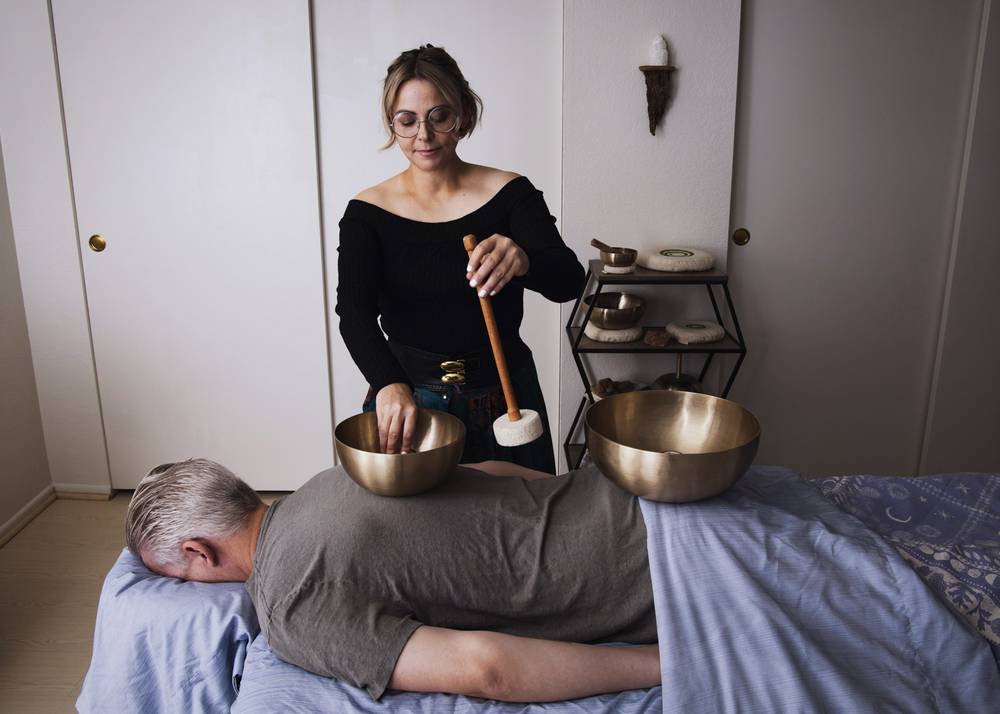Self-care might be more important now than ever before, but access to therapy, including touch therapy, isn’t always available or even desired during pandemic times. Over the past decade, one organization has utilized the modalities of sound and vibration to deliver healing and relaxation without the patient ever being touched by someone’s hands.
Founded in 2014 by sound therapist Jeff Howard, the Vibrational Sound Association (VSA) is the only official body that provides certification courses, instruction and advocacy for vibrational sound therapists. According to the website, vibrational sound therapy (VST) combines “powerful vibration and tones to induce an immediate relaxed state,” beneficial to the client in different ways.
A typical VST session looks similar to a massage treatment, beginning with the client lying face-up or face-down on a massage table. A practitioner then places therapeutic singing bowls directly on the client’s (clothed) body, allowing the induction of the sound waves to enter directly into the client.
“A practitioner engages with their client both physically and aurally,” the VSA website explains.
VST has certain strengths that other therapeutic modalities do not, especially for clients with trauma, PTSD or anxiety. “One major comfort barrier that prevents many people from receiving a traditional massage is fear of being touched by a stranger,” the website reads. “In the VST method, the client remains fully clothed and is never touched directly by the practitioner. In fact, because the singing bowl is doing most of the physical work, contact is kept to a minimum.”
Because VST doesn’t involve direct physical contact, it’s also great for people who get sore easily and prefer a therapeutic alternative to massage. It can be used in conjunction or in addition to reiki, psychotherapy, acupuncture and more.
Carey-Sue Kaplan, owner of Desert Vibration and Sound Therapy, is a Las Vegas-based, VST-certified practitioner with 23 years of experience in massage. Kaplan says the practice of VST is comparable to a sound bath and offers similar healing properties. The key difference between VST and a traditional sound bath is that VST incorporates vibration, not just sound, as a healing tool.
“A sound bath is an immersive sound experience, where one or many people are in a room that has really good acoustics,” Kaplan says. “They use all manner of instruments to make the sound crescendo to wash over you and create a deep sense of relaxation.”
Therapeutic singing bowls resemble traditional Tibetan bowls in their appearance, but they’re designed specifically for vibrational sound therapy.
According to the VST website, therapeutic singing bowls “are the first singing bowls designed as a tool to provide application of vibration directly to the body.” They’re made of resonant alloy, and “the notable audible differences between a therapeutic singing bowl … and a modern Himalayan singing bowl can be found in the subdued volume and the purity of tone of the therapeutic bowls.”
“They’re specifically made by artisanal workers, and they make them in specific ways to enhance the vibration of the bowl, so that when it’s placed on the body, you feel the vibration more than you hear the sound,” Kaplan explains. “The vibration throughout the body and the rhythmic sound creates a sense of relaxation.”
Vibrational sound therapy might be new, but Tibetan and Himalayan bowls have been used to hold food for thousands of years. It wasn’t until the spiritual tourism boom of the ’70s and ’80s that Westerners began purchasing them and incorporating them into their daily lives.
Kaplan says the benefits of vibration and sound as a form of therapy have been known for many years, but it wasn’t called vibrational sound therapy until recently. “That terminology didn’t come about until the ’80s, when crystal bowls came along,” she says.
Though not used in VST, quartz crystal singing bowls are commonly used in sound baths to induce a similar meditative response; however, these bowls are not placed on the body and don’t produce strong enough vibrations to be felt.
The experience is different for each individual, Kaplan explains, but there are broad benefits to VST. “It does all of the things massage would do in terms of physiological responses—it lowers blood pressure, calms the sympathetic nervous system, your heart rate slows, and you fall in and out of consciousness,” Kaplan says. “It’s very relaxing, but beyond that, everyone has a very subjective reaction. There are people who get energized, people who get sleepy, people who feel they’ve had a whole body massage or [experience] a release where they start crying. It’s choose-your-own-adventure.”
In addition, Kaplan says, VST can be beneficial for people who find meditation difficult. “If you can’t shut off your brain, VST allows you to focus on the rhythmic pulsing of the bowls, so it pushes you [into a meditative state]. Whereas if you’re in your head all the time, VST lets your thoughts float away from you with every hit of the bowl. It’s a really nice meditation tool if you can’t meditate.”
Click HERE to subscribe for free to the Weekly Fix, the digital edition of Las Vegas Weekly! Stay up to date with the latest on Las Vegas concerts, shows, restaurants, bars and more, sent directly to your inbox!


